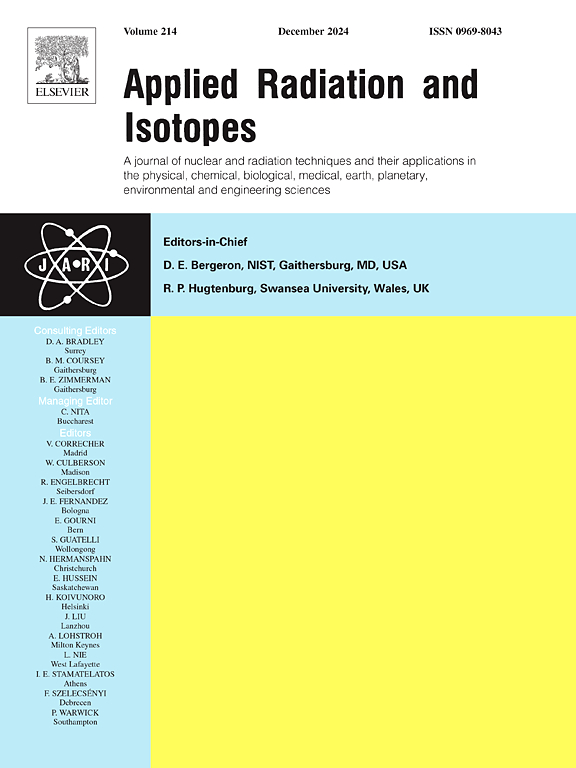Sm 掺杂氧化镁对 60Co 伽马射线的 TL 响应。
IF 1.6
3区 工程技术
Q3 CHEMISTRY, INORGANIC & NUCLEAR
引用次数: 0
摘要
研究了掺杂不同稀土的氧化镁的热致发光(TL)响应。TL 材料通过溶液燃烧法合成,并在 1173 K 下烧结;得到的粉末呈颗粒状。辐照前,剂量计在 623 K 下退火 30 分钟,以消除制造过程中产生的任何 TL 信号。在氧化镁中掺入 Tm、Dy、Ce 和 Sm 进行了独立测试。掺入 Sm 的氧化镁(MgO:Sm)的 TL 响应最高,Sm 含量为 0.4 摩尔% 时灵敏度最高。该样品的 TL 响应在 60Co 伽马射线的 0.001 至 500 Gy 范围内呈线性关系。检测下限为 1.17 μGy。MgO:Sm 制备的剂量计的灵敏度约为商用 TLD-100 的 10%。一个月后发现 TL 信号衰减为 6%。辉光曲线的解卷积显示了一个以 474 K 为中心的具有一般阶动力学 b 的对称峰。本文章由计算机程序翻译,如有差异,请以英文原文为准。
TL response of Sm-doped MgO to 60Co gamma radiation
The thermoluminescent (TL) response of MgO doped with different rare earths was investigated. The TL material was synthesized by the solution combustion method and sintered at 1173 K; the obtained powders were prepared in pellet form. Before irradiation, the dosimeters were annealed at 623 K for 30 min to eliminate any TL signal generated during their manufacture. Independent tests were performed doping the MgO with Tm, Dy, Ce and Sm. The highest TL response was found for Sm-doped MgO (MgO:Sm) reaching the highest sensitivity for 0.4 mol% of Sm. For this sample, the TL response showed linearity from 0.001 to 500 Gy of 60Co gamma radiation. The lower detection limit was found to be equal to 1.17 μGy. The sensitivity of the MgO:Sm prepared dosimeter was approximately 10% the sensitivity of the commercial TLD-100. The TL signal fading was found to be 6% after one month. The deconvolution of the glow curve showed a symmetric peak with a general order kinetics, b, centered at 474 K. These results suggest that this new TL material could be a promising detector to use in diverse dosimetry applications.
求助全文
通过发布文献求助,成功后即可免费获取论文全文。
去求助
来源期刊

Applied Radiation and Isotopes
工程技术-核科学技术
CiteScore
3.00
自引率
12.50%
发文量
406
审稿时长
13.5 months
期刊介绍:
Applied Radiation and Isotopes provides a high quality medium for the publication of substantial, original and scientific and technological papers on the development and peaceful application of nuclear, radiation and radionuclide techniques in chemistry, physics, biochemistry, biology, medicine, security, engineering and in the earth, planetary and environmental sciences, all including dosimetry. Nuclear techniques are defined in the broadest sense and both experimental and theoretical papers are welcome. They include the development and use of α- and β-particles, X-rays and γ-rays, neutrons and other nuclear particles and radiations from all sources, including radionuclides, synchrotron sources, cyclotrons and reactors and from the natural environment.
The journal aims to publish papers with significance to an international audience, containing substantial novelty and scientific impact. The Editors reserve the rights to reject, with or without external review, papers that do not meet these criteria.
Papers dealing with radiation processing, i.e., where radiation is used to bring about a biological, chemical or physical change in a material, should be directed to our sister journal Radiation Physics and Chemistry.
 求助内容:
求助内容: 应助结果提醒方式:
应助结果提醒方式:


